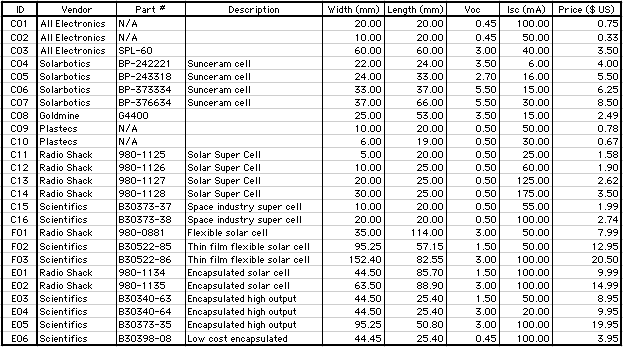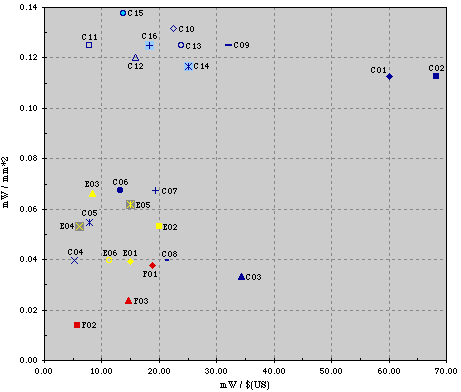|
|
BEAM Pieces is a BEAM Reference Library site.
Solar cells
What to look for, what to look
out for
When it comes down to buying solar cells, most of your decisions will come down to trading off a number of factors -- primarily:
- Price
Oftentimes, you get what you pay for ; sometimes, you get more; other times you get less. You really need to do your math before you decide that a higher-priced cell is too expensive (given its performance), or that a cheap cell is a good buy. I've pulled together comparison data in large part to help the BEAM community decide what is and isn't a good deal.
- Availability
You can often find really good deals on solar cells from surplus houses -- but when their supply is gone, it's gone. If you want to take advantage of such situations, you should consider keeping a reserve fund on hand for "opportunity buys." If / when you later find a high-performance cell at a good price, you'll be prepared to buy more than you need in the near term. Essentially you'll have to take a stance of "buy now, design (the 'bot) later" -- since what kind of cells will be (temporarily) cheap in the future isn't predictable.
- Size
The solar cell area you require will be a function of two things -- the amount of power you need (which in turn is a function of how much power your 'bot draws, and how often you want it to be active), and the performance of the solar cells you pick. Lower performing cells have larger cell area -- this may or may not "fit" with your desired BEAMbot design aesthetically, and can also cause mass problems.
- Mass
Heavier cells put more of a load on your BEAMbot, which usually means more of a load on your motor(s), which means more power consumption (which primarily has to be addressed by adding more cells...). Bear this in mind when you're looking at solar cell performance vs. size, particularly if you're considering buying encapsulated solar cells.
- Cell Voltage
Most BEAMbot designs require at least 3 volts from their solar cell(s). This means, of course, that if you buy 0.5 V cells, you need to wire together at least six of them to do the job. This may or may not be something you want to mess with; it may or may not fit with the aesthetic design you're shooting for.
To start with, I tabulated advertised data on solar cells sold by all the small-cell vendors I could find (including some surplus houses). The vendors I found were (alphabetically) All Electronics, Electronics Goldmine, Plastecs, Radio Shack, Scientifics, and Solarbotics. Note that I collected data on 3 cell types -- regular solar cells ("C**" ID numbers), flexible cells ("F**" ID numbers), and encapsulated cells ("E**" ID numbers).

Note that solar cells are available in a number of output voltages -- the most common being 0.5 V (this being a function of solar cell physics), but higher voltages also being available. Since most BEAMbots require solar cell output voltages of 3 - 5 volts, if you buy 0.5 V cells you must connect a number of them in series in order to provide a useful voltage.
In order to compare cells of various voltages, sizes, and costs, I had to construct some performance metrics. While Voc * Isc is not the maximum power a cell can produce (it's easily 20% higher than that), it is at least roughly proportional to a cell's peak power output. So, in order to find solar cells that produce a high power level for a given cost, and a high power level for a given size (and roughly, mass), these are the two metrics I used:
- Voc * Isc / Width * Length -- measured in mW / mm*2,
metric of performance vs. cell area (thus also a
rough metric of performance vs. mass)
- Voc * Isc / Cell price -- measured in mW / $(US), metric of performance vs. cost
When I plotted these cells on a chart using the selected metrics, here's what I came up with (note that here, the best performing cells for a given size and cost will be located toward the top right of the chart):

What can we deduce from this?
- Cells tend to group pretty neatly into two clusters
-- a higher-efficiency (i.e., higher performance per unit
area) one, and a lower-efficiency one. The higher
performance cluster also has slightly better performance
against cost, so in general the smaller required cell
area doesn't translate into higher price tags.
- Encapsulated cells lie solidly in the lower
performance cluster. Their advantages (water resistance,
slight improvement in performance in light collected from
off-normal angles) must be weighed against their
increased size and mass (due both to size and their
plastic encapsulation).
- Flexible cells also lie solidly in the lower
performance cluster. The design flexibility (no pun
intended) you gain from them must be offset against the
larger size required for a given power requirement.
- Occasionally you can find a really good deal in surplus cells. C01 and C02 on this chart were surplus calculator solar cells -- good performance vs. size, and a really exceptional deal (mW / $). Only annoying thing about them was their low (0.5 V) output voltage -- should have bought more when I had the chance.
So, how can you tell if an advertised cell is a good deal? I've got the above plot, along with a JavaScript utility to quickly calculate my two performance metrics for any cell -- on a separate page.
|
|
|
Solarbotics
has detailed test
data on the Sunceram cells they stock; this is
great stuff, lots of real-world data providing
design guidelines for BEAMbots. Meanwhile,
Panisonic's Sunceram data sheet (more technical) is
archived in the BEAM
Reference Library's Datasheet
collection here. |
|
|
||
|
|
This page was last updated on |
|